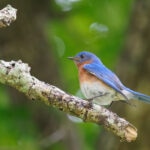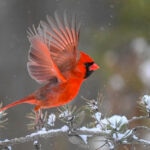Orioles 101: What They Eat, Where They Live, and How To Attract Them

Photo by Irving A Gaffney/iStock/Getty Images Plus
Known for their fiery orange feathers, orioles are a favorite of backyard birders. Attracting them to your garden requires a setup similar to that of hummingbirds, with a few key differences.
Keep reading to learn more about these fellow nectar-lovers and how to make your yard an oriole-friendly zone.
Key Takeaways
- Orioles are vibrant birds that are part of the blackbird family.
- Several oriole species live in the U.S., including the Baltimore oriole, Bullock’s oriole, and orchard oriole.
- Most orioles are migratory, though some species stay in the same place year-round.
- Oriole birds eat insects, nectar, fruit (like oranges), and even jelly.
What Is an Oriole?
Unique members of the blackbird family, orioles have brightly colored plumage with blazes of orange on their feathers.
These birds are known for their cheerful songs and for making a special type of nest that looks like a hanging basket suspended from tree branches. They’re fun to attract with special oriole feeders or by putting out oranges in the springtime.
Like many birds, male and female orioles look quite different from one another, says Stephanie Beilke, senior manager of conservation science at Audubon Great Lakes. The males are typically more brightly colored, while female orioles are more subdued to help them stay camouflaged when tending to the nest.
Types of Orioles
Several oriole species can be found across the United States. While the Baltimore oriole may be the most recognizable (thanks, Major League Baseball!), it’s far from the only one.
Here’s a quick look at this and other species you might spot:
- Baltimore oriole: Found east of the Rockies and in parts of Canada, the Baltimore oriole breeds in open woodlands and suburbs, migrating south to Florida, the Caribbean, and Central or South America. “Baltimore orioles are the most abundant oriole in the U.S.,” explains Maria Kincaid, an ornithologist with FeatherSnap.
- Orchard oriole: Slightly smaller and darker in color than the Baltimore oriole, Kincaid says this is the second most common oriole in the U.S. “Orchard orioles breed in the eastern and central U.S. and winter in Mexico, Central America, and northern South America.”
- Bullock’s oriole: Known for their bright orange breast and bold black-and-white patterning, Bullock’s orioles breed in the western U.S. and southern parts of western Canadian provinces. Their winter range extends from Mexico into Central America.
- Scott’s oriole: A western species found in parts of the Southwest and Mexico, Kincaid notes Scott’s orioles are relatively short-distance migrators, wintering in Mexico. They’re often found in arid, mountainous habitats—especially near yucca trees.
- Hooded oriole: A Southwestern species and partially migratory, male Hooded orioles sport bright yellow-orange feathers with a distinctive black mask. “[They] prefer riparian areas that have trees like palms, cottonwoods, and willows,” Kincaid says.
- Audubon’s oriole: Mostly found in Mexico, the Audubon’s oriole can also be seen in southern Texas and is considered nonmigratory. Black and lemon-yellow plumage sets the Audubon apart from other orange orioles.
- Altamira oriole: The least common oriole regularly found in the U.S., Kincaid notes the Altamira is non-migratory, with a range in Mexico and Central America extending into southern Texas in the lower Rio Grande Valley. Altamiras are large and vividly colored with an orange head and body.
Where Do Orioles Live?
The regions orioles prefer really depends on their species.
“Baltimore, orchard, and Bullock’s orioles prefer open areas like woodland edges or open forests, especially when there are sources of water nearby,” Kincaid says. “Scott’s orioles breed in arid habitats, usually in the mountains, and often in association with yucca trees.”
She adds that hooded orioles are also a desert species but prefer different types of trees that tend to grow near water sources.
You may be more likely to attract orioles in the spring and summer if you live near a forest or forest edge, especially if you live near a forested river or stream.
Oriole Migration
Orioles are true travelers, journeying thousands of miles each year between their breeding and wintering grounds. “Most, but not all, of them are migratory,” says Kincaid.
In spring, Baltimore and orchard orioles begin their journey north from Central and South America, with migration peaking between April and May. Bullock’s orioles follow a similar pattern in the western U.S., starting as early as March and moving through May.
By late summer, the pattern reverses. “After orioles finish nesting in the late summer, they migrate south and overwinter in Florida, Mexico, Central and South America,” says Beilke.
While most orioles migrate, some western species, such as Scott’s and hooded orioles, make shorter trips or may even remain in parts of their range year-round, depending on local conditions.
What Do Orioles Eat?
Like other nectar enthusiasts (hummingbirds), orioles eat insects and fruit. But they have a little more variety in their diet thanks to their fondness for oranges.
Beilke says a good way to supplement oriole diets (and help attract them to your space) is by providing half slices of oranges or nectar for them to snack on. “Usually, the best time to do this is in the spring, from April to June.”
Recommended Product
You can even entice orioles with jelly—but do so with caution. Beilke warns that it can be very sticky, which may make it difficult for a bird to fly if they get jelly on their feathers.
If you do offer jelly, make sure it’s well-contained and avoid kinds that use sugar alternatives such as high-fructose corn syrup.
How To Attract Orioles
While orioles may sip from the nectar in hummingbird feeders, it’s best to buy an oriole feeder, such as the Natures Way Wire Oriole Bird Feeder or the Perky-Pet Vine Oriole Bird Feeder, which are specially designed for these birds. Orioles are larger and need more space and an adequate perch.
Recommended Products
Oriole feeders are usually orange and come with compartments for orange halves, jelly, or nectar.
To make oriole nectar, Beilke says a 4:1 ratio of water to white granulated sugar is best. “Strictly avoid other types of sugar, honey, or artificial sweetener,” she says. “Mix water and sugar, boil, and then let cool before adding to a feeder.”
And skip the food dye—Beilke notes that it’s unnecessary.
As with hummingbird feeders, be sure to empty and clean nectar feeders every two to three days, especially in warmer weather.
To make your space even more oriole-friendly, plant native flowering and fruit trees and shrubs, and provide water sources such as a birdbath or fountain.
“Flowering and fruiting shrubs and trees such as crabapple and cherry may provide additional food,” Beilke says.
FAQs About Orioles
What states do orioles live in?
Orioles can be found in nearly every region of the continental U.S., depending on the species and season. However, they’re largely absent from Alaska, Hawaii, the Pacific Northwest, and extreme desert or alpine regions that lack trees and insects.
Do orioles eat the same things as hummingbirds?
Similar, but not exactly. While they also enjoy insects and nectar from brightly colored flowers and feeders, orioles eat fruit as well.
They may visit hummingbird or oriole feeders “for sips of energy-rich nectar,” Kincaid says, but they also need insects for protein.
What kind of birdhouses do orioles like?
Orioles build special woven nests and, Beilke explains, do not typically use birdhouses.
What is the difference between a robin and an oriole?
While both birds feature orange coloring, orioles belong to the blackbird family and weave nests that hang from trees. Their vivid orange and black colors make them stand out. Unlike robins, they’re more likely to sip nectar or eat fruit.






